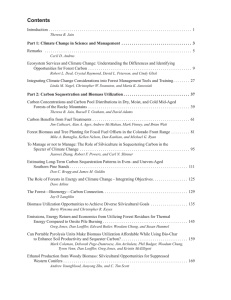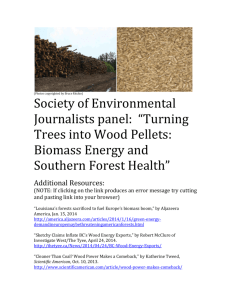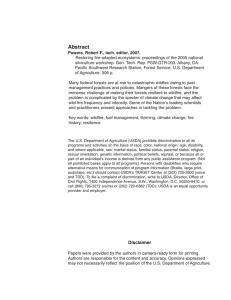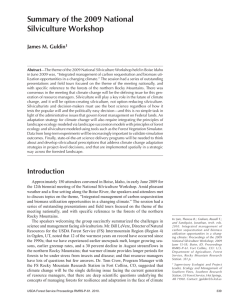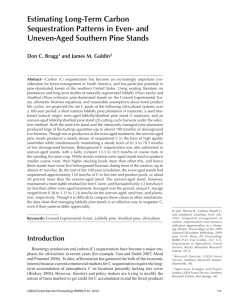Introduction Theresa B. Jain
advertisement
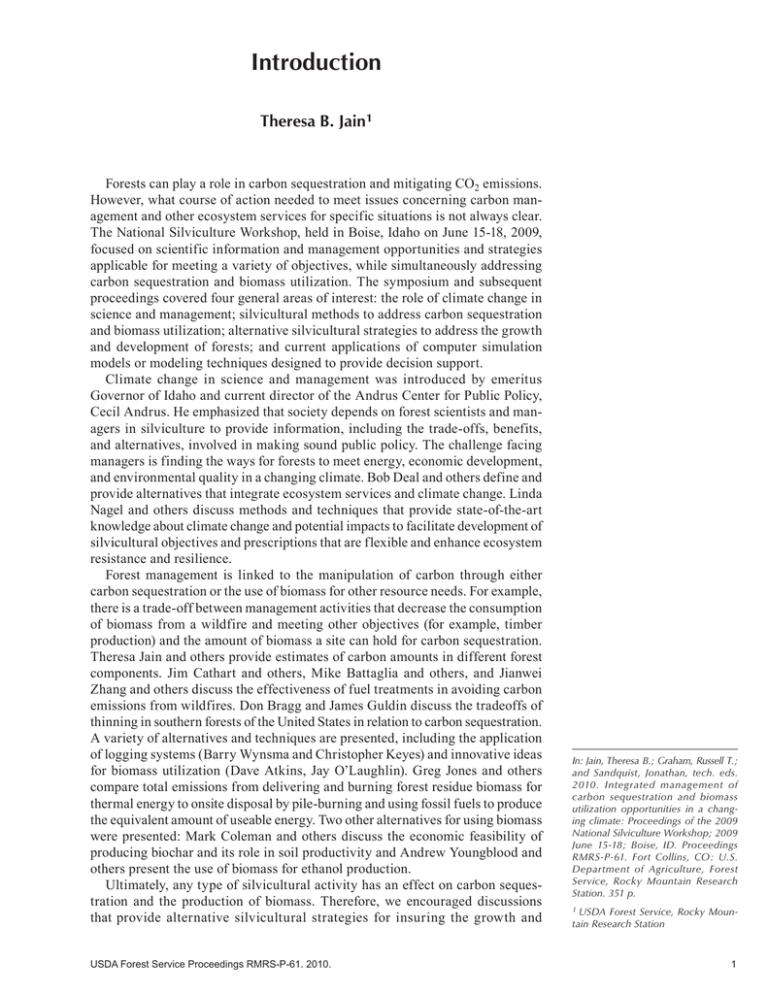
Introduction Theresa B. Jain1 Forests can play a role in carbon sequestration and mitigating CO2 emissions. However, what course of action needed to meet issues concerning carbon management and other ecosystem services for specific situations is not always clear. The National Silviculture Workshop, held in Boise, Idaho on June 15-18, 2009, focused on scientific information and management opportunities and strategies applicable for meeting a variety of objectives, while simultaneously addressing carbon sequestration and biomass utilization. The symposium and subsequent proceedings covered four general areas of interest: the role of climate change in science and management; silvicultural methods to address carbon sequestration and biomass utilization; alternative silvicultural strategies to address the growth and development of forests; and current applications of computer simulation models or modeling techniques designed to provide decision support. Climate change in science and management was introduced by emeritus Governor of Idaho and current director of the Andrus Center for Public Policy, Cecil Andrus. He emphasized that society depends on forest scientists and managers in silviculture to provide information, including the trade-offs, benefits, and alternatives, involved in making sound public policy. The challenge facing managers is finding the ways for forests to meet energy, economic development, and environmental quality in a changing climate. Bob Deal and others define and provide alternatives that integrate ecosystem services and climate change. Linda Nagel and others discuss methods and techniques that provide state-of-the-art knowledge about climate change and potential impacts to facilitate development of silvicultural objectives and prescriptions that are flexible and enhance ecosystem resistance and resilience. Forest management is linked to the manipulation of carbon through either carbon sequestration or the use of biomass for other resource needs. For example, there is a trade-off between management activities that decrease the consumption of biomass from a wildfire and meeting other objectives (for example, timber production) and the amount of biomass a site can hold for carbon sequestration. Theresa Jain and others provide estimates of carbon amounts in different forest components. Jim Cathart and others, Mike Battaglia and others, and Jianwei Zhang and others discuss the effectiveness of fuel treatments in avoiding carbon emissions from wildfires. Don Bragg and James Guldin discuss the tradeoffs of thinning in southern forests of the United States in relation to carbon sequestration. A variety of alternatives and techniques are presented, including the application of logging systems (Barry Wynsma and Christopher Keyes) and innovative ideas for biomass utilization (Dave Atkins, Jay O’Laughlin). Greg Jones and others compare total emissions from delivering and burning forest residue biomass for thermal energy to onsite disposal by pile-burning and using fossil fuels to produce the equivalent amount of useable energy. Two other alternatives for using biomass were presented: Mark Coleman and others discuss the economic feasibility of producing biochar and its role in soil productivity and Andrew Youngblood and others present the use of biomass for ethanol production. Ultimately, any type of silvicultural activity has an effect on carbon sequestration and the production of biomass. Therefore, we encouraged discussions that provide alternative silvicultural strategies for insuring the growth and USDA Forest Service Proceedings RMRS-P-61. 2010. In: Jain, Theresa B.; Graham, Russell T.; and Sandquist, Jonathan, tech. eds. 2010. Integrated management of carbon sequestration and biomass utilization opportunities in a changing climate: Proceedings of the 2009 National Silviculture Workshop; 2009 June 15-18; Boise, ID. Proceedings RMRS-P-61. Fort Collins, CO: U.S. Department of Agriculture, Forest Service, Rocky Mountain Research Station. 351 p. 1 USDA Forest Service, Rocky Mountain Research Station 1 Jain Introduction development of forests that meet a variety of objectives. Because quantification of forest metrics continues to be a challenge, alternative approaches were presented. Henry McNab evaluates the inclusion of shrubs for estimating site index in oak dominated forests. John Shaw and James Long discuss the limitations and confusion concerning the application of Reineke’s Stand Density Index and provide guidelines to avoid the misapplication of this metric. Moser and others discuss how FIA data can be used for Forest Plan revision, monitoring conditions and trends at mid- to broad spatial scales over time, and to set the context for proposed projects. Two manuscripts focus on implementation of silviculture treatments: Christopher Keyes and others evaluate the effectiveness and challenges involved with accomplishing variable density prescriptions and Matt Busse discusses the tradeoff between maintaining long-term soil productivity and removing biomass, an issue that creates much discussion among managers. Although silviculture can influence the role of disturbances at multiple spatial scales, it is a discipline that focuses on site specific management activities. Douglas Basford and others present a method, adapted from a model developed for tree species on the Salmon National Forest, for estimating stand growth from stand density and average diameter in stands of pure and mixed species in southwest Idaho. Christopher Keys and Thomas Perry highlight the role of experimental forests, using Lubrecht as an example, to implement and demonstrate alternative silvicultural strategies. Associated with climate change is an element of uncertainty. Typically uncertainty is addressed through the development and application of models which are used to evaluate a variety of scenarios that are applicable in decision support. Nicholas Crookston and others introduce a modification of the Forest Vegetation Simulator (FVS) to account for climate change. Melinda Moeur and Don Vandendriesche describe how FVS is being used with regional inventory data to empirically derive state transition models such as residence times in states, pathways between states, and transition probabilities between states, and to link these outputs to vegetation states. Don Vandendriesche provides a set of guidelines for using FVS and also discusses the process for estimating natural regeneration. Reuben Weisz and others present a methodology for developing a state-and-transition model with the Vegetation Dynamics Development Tool (VDDT), using outputs from FVS. James Guldin closes this proceedings by summarizing the workshop, including the field tour and discussions. He concludes that there was a consensus in the meeting that climate change will be the defining issue for this generation of resource managers and that silviculture will play a key role. The content of this paper reflects the views of the authors, who are responsible for the facts and accuracy of the information presented herein. 2 USDA Forest Service Proceedings RMRS-P-61. 2010.

